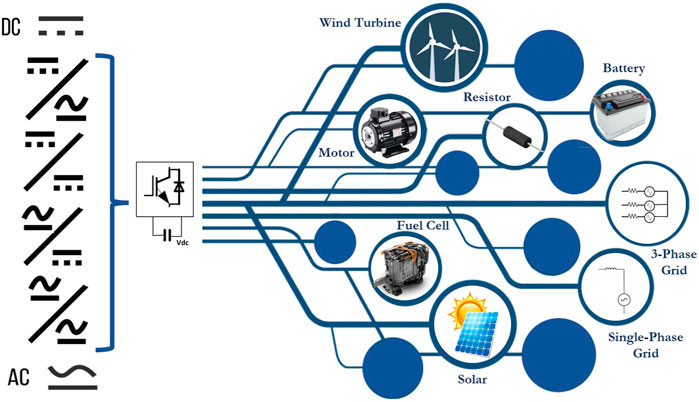- 1Laboratory of Power and Control Systems (LSPyC), Facultad de Ingeniería, Universidad Nacional de Asunción, Luque, Paraguay
- 2Department of Electrical Engineering, University of Málaga, Málaga, Spain
- 3The Power Electronics and Industrial Control Research Group (GRÉPCI), École de Technologie Supérieure, Montreal, QC, Canada
Editorial on the Research Topic
Recent Advances in Control of Energy Conversion Systems
Using more environmentally friendly sources of electricity generation is a matter of global interest associated mainly with mitigating the environmental impact produced by fossil fuels. In this context, in recent years, the research in electrical, electronic, and control engineering has mainly focused on renewable energy applications such as solar and wind energy conversion systems. These systems need advanced control techniques to comply with grid connection standards or increase efficiency, among other issues. For this reason, this Research Topic focuses on applying advanced control strategies to power electronic converters and electric machines/generators for applications in renewable energy. In the case of voltage source converters, they are the core of the energy conversion systems and permit managing the power for integrating new technologies with distributed energy, as shown in Figure 1.
Based on the crucial role of electric drives in the development of more sustainable use of energy, this Research Topic of Frontiers in Energy Research included the following points:
• Advanced control methods of three-phase and multiphase electric motor drives.
• Advanced control methods of power electronic converter, i.e., matrix converter and multilevel inverters.
• Power electronic converters for renewable energy applications, i.e., wind energy and photovoltaics.
• Power converters for grid-connected applications, i.e., active power filters.
• Recent advances in linear or nonlinear control techniques for power electronic converters and electric motors/generators.
• Modulation techniques of power converters.
• Fault-tolerant multiphase machines.
• Advanced control methods of grid integration by electronic power inverters.
A summary of the contributions to this Research Topic is presented below.
In (Rodas et al.), the latest advances in two of the most well-known nonlinear control techniques, Sliding Mode Control (SMC) and Model Predictive Control (MPC), applied as a current regulator of five and six-phase induction machines, are presented. A detailed mathematical model of the power converter is also introduced. The manuscript allows the reader to know in a simple manner the necessary stages to implement these nonlinear strategies, identifying those points that require particular attention. In addition, this review paper includes an experimental comparison among the most relevant SMC and MPC approaches.
An exciting MPC algorithm is proposed in (Renault et al.) for a current regulator of a shunt active power filter based on 7-level cascaded H-bridge converters. The proposed MPC is combined with the space vector modulation approach to achieve a real-time implementation. Experimental results demonstrated a compensation of the current harmonics on the grid side caused by nonlinear loads connected to the point of common coupling.
Considering the increase in the use of resonant power converters in modern power and renewable energy applications (Bughneda et al.), presented a comprehensive review of these power converters. This work describes the latest developments in the field of resonant power converters and analyses their main performance indices and new challenges in the area. Moreover, the implementation of these power converters in renewable energy applications is introduced. Finally, the future challenges to exploiting the advantages of these electric drives are exposed. The required modifications can be related to the circuit design or developing more competitive regulation strategies.
In (Li et al.) a method based on a Radial Basis Function Neural Network (RBFNN) is proposed to improve the output voltage response of DC converters caused by load mutation. The goal of this paper is to mitigate the reduced capability of proportional-integral controllers to regulate the abrupt load changes in isolated DC-DC converters. For that purpose, the output voltage deviation and the load current values are identified. Later, the proposed method provides compensation in the duty ratio to enhance the voltage output. An experimental platform is built for this work, and in addition, this one is employed to confirm the goodness of the developed method.
Author contributions
All authors listed have made a substantial, direct, and intellectual contribution to the work and approved it for publication.
Acknowledgments
The Topic Editors would like to take the opportunity to thank the authors who responded to the call. We are also deeply indebted to the reviewers whose input was indispensable to select the published papers.
Conflict of interest
The authors declare that the research was conducted in the absence of any commercial or financial relationships that could be construed as a potential conflict of interest.
Publisher’s note
All claims expressed in this article are solely those of the authors and do not necessarily represent those of their affiliated organizations, or those of the publisher, the editors and the reviewers. Any product that may be evaluated in this article, or claim that may be made by its manufacturer, is not guaranteed or endorsed by the publisher.
Keywords: electric motor drives, nonlinear control, power electronic converters, renewable energy applications
Citation: Rodas J, Gonzalez-Prieto I and Kali Y (2022) Editorial: Recent advances in control of energy conversion systems. Front. Energy Res. 10:1003814. doi: 10.3389/fenrg.2022.1003814
Received: 26 July 2022; Accepted: 01 August 2022;
Published: 16 September 2022.
Edited by and reviewed by:
Zhaoyang Dong, Nanyang Technological University, SingaporeCopyright © 2022 Rodas, Gonzalez-Prieto and Yassine, Kali. This is an open-access article distributed under the terms of the Creative Commons Attribution License (CC BY). The use, distribution or reproduction in other forums is permitted, provided the original author(s) and the copyright owner(s) are credited and that the original publication in this journal is cited, in accordance with accepted academic practice. No use, distribution or reproduction is permitted which does not comply with these terms.
*Correspondence: Jorge Rodas, anJvZGFzQGluZy51bmEucHk=
 Jorge Rodas
Jorge Rodas  Ignacio Gonzalez-Prieto
Ignacio Gonzalez-Prieto  Yassine Kali
Yassine Kali 